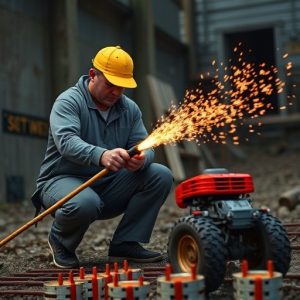Mastering the Kubotan: An Introduction to Its Origins and Self-Defense Techniques for Effective Use
The Kubotan is a versatile self-defense tool rooted in traditional martial arts and invented by Tak…….
The Kubotan is a versatile self-defense tool rooted in traditional martial arts and invented by Takayuki Kubota. It serves as an extension of one's hand in combat, offering users a means to enhance their defensive capabilities through specialized stances and techniques. Mastery of the Kubotan requires understanding its historical basis, its modern application as a personal protection tool, and the anatomy and biomechanics involved in its use. Training involves learning to grip and manipulate the Kubotan effectively for strikes, blocks, and pressure point applications, which can be used to control an opponent or respond to both armed and unarmed threats. To become proficient with a Kubotan, one must practice a range of offensive and defensive maneuvers that utilize its design to maximize impact or apply pressure on sensitive areas. Regular training that simulates real-life confrontations is essential for adeptly using the Kubotan in self-defense scenarios, ensuring users can respond swiftly and accurately with precision and control. Understanding how to use a Kubotan correctly is crucial for safety and effectiveness in potentially dangerous situations.
Exploring the intricacies of the Kubotan fighting system, this article serves as a comprehensive guide for those interested in mastering its application. Originating from the Filipino martial art of Eskrima, the Kubotan is a short, thick stick designed for self-defense and its techniques are both precise and effective when wielded correctly. We will delve into the origins of this self-defense tool, the key stances and movements that define it, and how to effectively use it in combat situations. Whether you’re new to the art or looking to refine your skills, understanding how to use a Kubotan can be a valuable addition to your self-defense repertoire.
Mastering the Kubotan: An Overview of Its Origins and Techniques
The Kubotan is a self-defense tool that has gained prominence as an effective means of personal protection, incorporating elements from various martial arts, including jujutsu and karate. Originally designed by Takayuki Kubota in the 1940s to augment his own teaching methods, this versatile device now serves as a key element in self-defense training worldwide. To wield the Kubotan proficiently, one must understand its origins rooted in traditional martial arts and appreciate its development as a modern self-defense technique. The Kubotan is a short, thick stick with a blunt end; it can be used alone or in conjunction with empty-hand techniques. Practitioners learn how to use a Kubotan by mastering various stances and movements that optimize its use for defense against armed or unarmed attackers. The training encompasses both offensive and defensive maneuvers, teaching the user to control an adversary’s limbs, neutralize threats, and create distance to escape harm. The techniques associated with the Kubotan are designed to be practiced diligently to ensure a high level of proficiency, making it a reliable tool for those seeking enhanced self-defense skills.
The Mechanics of Kubotan Self-Defense: Key Stances and Movements
The Kubotan is a self-defense tool that has gained prominence for its effectiveness in various martial arts, particularly within the discipline of Kenpo. This versatile device, resembling a short stick with a cap on one end, is used to extend the range and power of one’s techniques. To effectively use a Kubotan, understanding the key stances and movements is crucial. A practitioner must be well-versed in the fundamentals of stance stability, which include the cat stance, horse stance, and bow stance, as these provide a solid base from which to execute Kubotan moves with precision and control.
The mechanics of Kubotan self-defense encompass a range of strikes, blocks, and manipulations that leverage the tool’s design to maximize impact. For instance, the thumb-end of the Kubotan can be used to apply pressure or deliver strikes to vulnerable areas of an assailant, such as the nerves at the base of the skull or the joints. The practitioner must learn to grip the Kubotan firmly yet flexibly to channel energy effectively without compromising their hand’s integrity. Additionally, movements like wrist locks, disarms, and pressure point applications are integral to the system. These techniques require a deep understanding of anatomy and biomechanics to execute safely and efficiently. Mastery of the Kubotan involves consistent practice and a thorough grasp of its application within the broader context of self-defense.
Effective Application of the Kubotan in Combat Situations: A Step-by-Step Guide
The Kubotan is a versatile self-defense tool that, when used effectively, can be a game-changer in combat situations. To employ the Kubotan successfully, one must first understand its potential applications and integrate it into their training. When confronted with an aggressor, the Kubotan allows for leverage and force multiplication, transforming your strikes into more powerful blows than those you could deliver unarmed. To begin, grasp the Kubotan between your index finger and thumb, ensuring a firm yet flexible grip. This will enable precise control during maneuvers.
In a conflict, the Kubotan’s application starts with distance management. Maintain a safe space between you and your adversary to avoid grappling range. Should the attacker close the gap, utilize the Kubotan to deflect or strike key pressure points, such as the nose, eyes, or joints. A well-placed strike can incapacitate an opponent without resorting to deadly force. After neutralizing the threat, it’s crucial to maintain control and seek a safe escape route. Training with a Kubotan should include drills that simulate real-life scenarios, emphasizing the importance of reaction time, accuracy, and situational awareness. Mastery of the Kubotan requires consistent practice, understanding its limitations, and knowing when its use is justified in self-defense situations.


